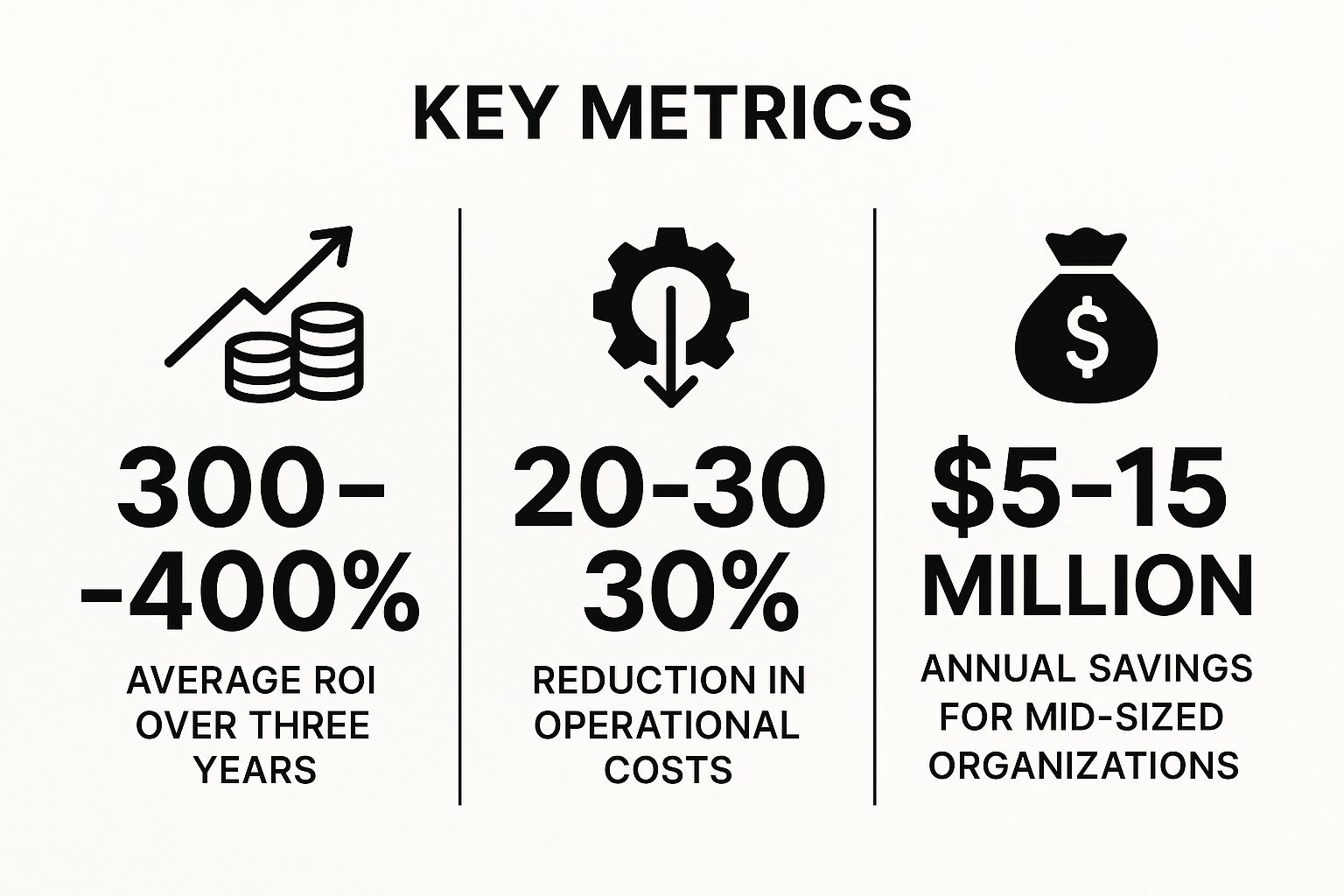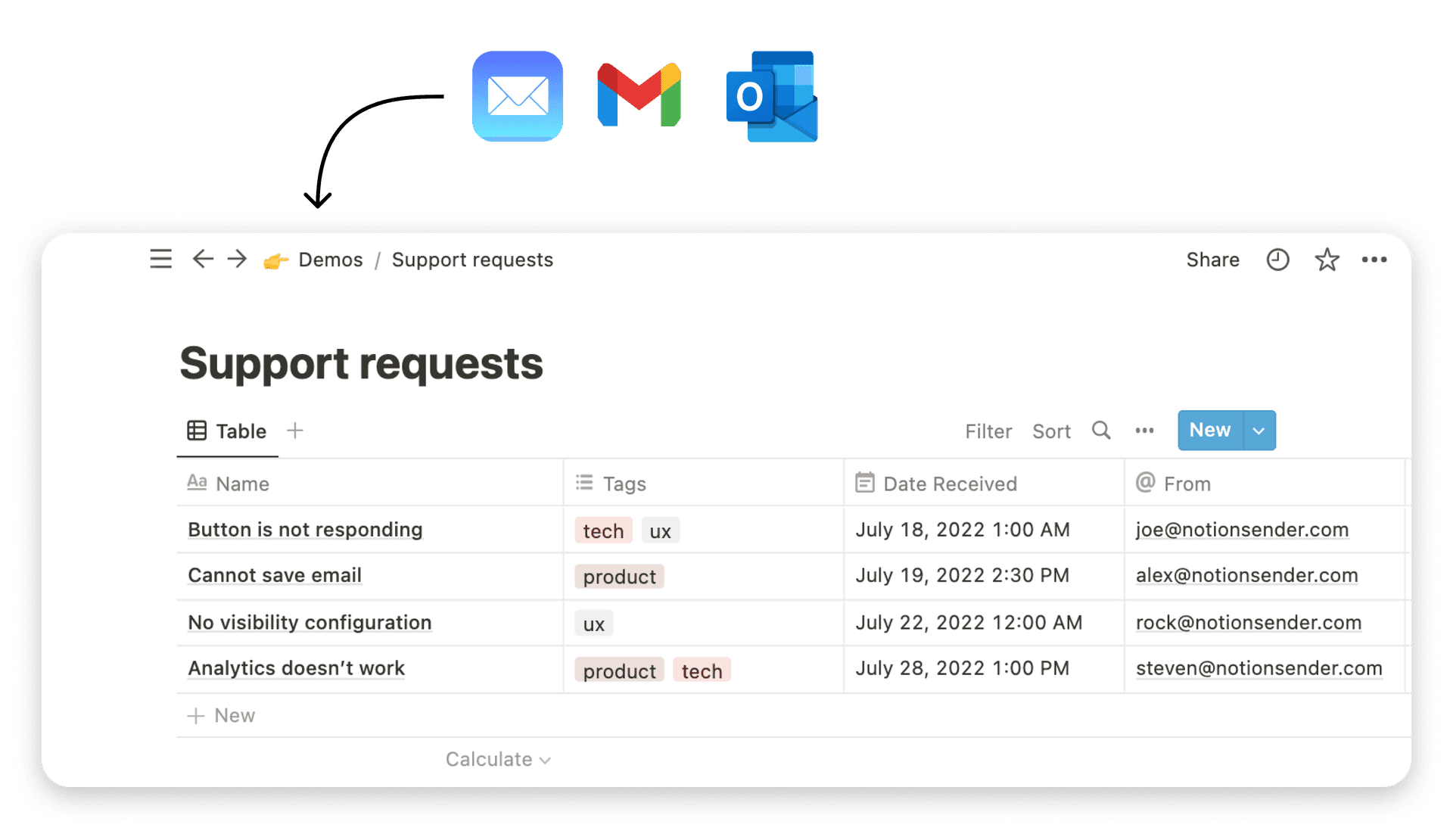8 Key Knowledge Management System Benefits for 2025

In a fast-paced business environment, the ability to effectively harness collective knowledge is no longer a luxury; it's a critical competitive advantage. Organizations are sitting on a goldmine of information, but it's often fragmented across different departments, hidden in email inboxes, or lost when an experienced employee leaves. A knowledge management system (KMS) acts as the central brain for your organization, systematically capturing, sharing, and leveraging this invaluable asset.
Implementing such a system might seem like a significant undertaking, but the strategic advantages are transformative. While a KMS focuses on organizing collective intelligence, it complements broader strategies for handling digital assets. To fully unlock your organization's untapped potential and gain strategic advantage, understanding the broader landscape and the 7 Key Benefits of Enterprise Content Management can provide a more complete picture of how to manage all your critical business information effectively.
This article will move beyond theory to explore the eight most impactful knowledge management system benefits. We will provide actionable insights, real-world examples, and clear metrics to demonstrate how a KMS can directly drive efficiency, foster innovation, and secure your company's long-term success. You will learn precisely how this technology translates into improved decision-making, faster onboarding, and a stronger bottom line.
1. Improved Decision-Making Through Centralized Information Access
One of the most significant knowledge management system benefits is its ability to empower faster, more intelligent decision-making across an organization. By dismantling information silos and consolidating expertise into a single, searchable repository, these systems provide decision-makers at all levels with a complete, contextualized view of relevant data. This ensures that choices are not made based on isolated anecdotes or incomplete information but are grounded in a comprehensive understanding of historical performance, collective wisdom, and best practices.
When a project manager needs to assess the risk of a new initiative, they can instantly access post-mortems from similar projects. When a sales representative encounters a unique client objection, they can find proven rebuttals and case studies. This immediate access to the full spectrum of organizational knowledge reduces guesswork, minimizes costly errors, and accelerates the entire decision-making cycle from days to minutes.

Real-World Impact
Global consulting firm Accenture provides a powerful example with its Knowledge Exchange (KX) platform. Serving over 500,000 employees, KX offers a centralized hub for proposals, market research, and industry-specific best practices. This allows a consultant in one country to leverage the successful strategies of a team on another continent, ensuring clients receive the best, most informed solutions, regardless of their consultant's individual experience. This model demonstrates how a KMS transforms individual knowledge into a strategic, enterprise-wide asset.
Actionable Implementation Tips
To maximize this benefit, focus on usability and data quality:
- Implement a robust search function: Use tools with natural language processing (NLP) so users can find information by asking questions in plain language, not just by matching keywords.
- Establish a clear taxonomy: Create a logical structure with consistent tagging and categorization. This prevents the system from becoming a disorganized "data dump" and makes navigation intuitive.
- Enforce data governance: Set clear policies for who can create, approve, and archive content. This ensures the information remains accurate, current, and trustworthy. Regularly audit and prune outdated materials.
2. Enhanced Employee Productivity and Efficiency
Another critical one of the knowledge management system benefits is the direct and measurable boost to employee productivity. A KMS dramatically reduces the time employees waste searching for information, answering repetitive questions from colleagues, or recreating solutions that already exist within the organization. By providing instant, on-demand access to documented processes, proven best practices, and expert knowledge, these systems empower workers to shift their focus from frustrating information-hunting to high-value, strategic tasks.
This shift is not trivial; it translates into significant operational efficiency. When an employee can find the answer to a complex technical question in seconds rather than hours, projects move forward faster, deadlines are met more consistently, and innovation is accelerated. The system becomes the primary "source of truth," eliminating the need to interrupt subject matter experts and allowing everyone to operate with greater autonomy and confidence.

Real-World Impact
A classic example is Dell, which implemented a sophisticated knowledge management system for its technical support division. By creating a centralized repository of troubleshooting guides, product specifications, and solutions to common customer issues, they significantly streamlined the support process. The result was a 14% decrease in average call handling time, which not only improved customer satisfaction but also allowed each support agent to handle more inquiries per day, directly boosting team productivity and operational efficiency.
Actionable Implementation Tips
To translate your KMS into real productivity gains, focus on adoption and accessibility:
- Integrate the KMS into existing workflows: Embed search functionality directly within tools your team already uses, like Slack, Microsoft Teams, or your CRM. This removes friction and makes knowledge access a natural part of the workday.
- Create easy-to-use templates: Encourage knowledge contribution by providing structured templates for different content types, such as project post-mortems, how-to guides, or meeting notes. This lowers the barrier to sharing.
- Use analytics to guide content creation: Regularly review search queries and identify frequently asked questions or knowledge gaps. Prioritize creating and refining content that addresses these high-demand topics to deliver maximum impact.
3. Accelerated Employee Onboarding and Training
Another of the most impactful knowledge management system benefits is the dramatic acceleration of employee onboarding and training. These platforms transform the new hire experience by providing structured, on-demand access to the full scope of organizational knowledge, from critical processes to cultural norms. Instead of relying on the limited availability of busy colleagues, new employees can self-serve information, reducing anxiety and shortening their time-to-productivity significantly.
A KMS acts as a single source of truth, housing everything a new team member needs: training modules, process documentation, video tutorials, and frequently asked questions. This structured environment ensures consistency in training across the board and allows new hires to learn at their own pace, revisiting complex topics as needed. This approach not only empowers employees from day one but also frees up valuable time for managers and senior staff.
<iframe width="560" height="315" src="https://www.youtube.com/embed/Ub7zkw7D23w" frameborder="0" allow="accelerometer; autoplay; clipboard-write; encrypted-media; gyroscope; picture-in-picture" allowfullscreen></iframe>
Real-World Impact
Professional services giant Deloitte provides a compelling case study. By implementing a dedicated onboarding knowledge management system, the firm successfully reduced the ramp-up time for new consultants from six months to just three. This system provided a centralized repository for project methodologies, client case studies, and internal best practices, allowing new hires to contribute to client projects much faster and more confidently.
Actionable Implementation Tips
To turn your KMS into a powerful onboarding engine, consider these strategies:
- Create role-specific learning paths: Develop tailored onboarding tracks for different departments or roles instead of a one-size-fits-all approach. This ensures new hires receive relevant information without being overwhelmed.
- Incorporate real-world scenarios: Move beyond theoretical knowledge by including case studies, simulations, and examples from actual work situations to provide practical context. Effective knowledge management often relies on dedicated platforms. For instance, understanding Mastering Enterprise Learning Management Systems can streamline training and boost ROI.
- Pair digital resources with human connection: Complement the self-service resources in your KMS with a buddy system or mentorship program to provide social support and answer nuanced, culture-related questions.
4. Preservation and Retention of Organizational Knowledge
One of the most critical knowledge management system benefits is its role as a safeguard against institutional memory loss. When experienced employees retire, resign, or change roles, they often take decades of invaluable tacit knowledge with them. A KMS acts as a corporate memory bank, systematically capturing this expertise, documenting lessons learned, and storing critical operational intelligence that would otherwise be lost forever. This prevents the costly "brain drain" that can cripple projects and erode long-term competitive advantages.
By creating a structured process for documenting expertise, organizations ensure business continuity and stability. Instead of new team members having to rediscover solutions to old problems, they can tap into a repository of proven processes, project histories, and expert insights. This protects the intellectual capital built over years of experience, turning the unique knowledge of individuals into a permanent, accessible, and strategic organizational asset.
Real-World Impact
Aerospace giant Boeing faced a significant challenge as a generation of highly experienced engineers approached retirement. To prevent the loss of decades of aircraft design and manufacturing expertise, the company launched a comprehensive knowledge retention initiative. Using their KMS, they captured critical design principles, complex engineering processes, and lessons from past projects. This allowed them to transfer vital knowledge to the next generation of engineers, ensuring the continuity of their high standards for safety and innovation, and preventing costly relearning cycles on new aircraft programs.
Actionable Implementation Tips
To effectively preserve and retain knowledge, focus on proactive capture and cultural integration:
- Conduct 'knowledge harvesting' interviews: Before key employees retire or depart, schedule structured interviews to document their critical processes, decision-making logic, and key contacts. Transcribe and store these sessions in the KMS.
- Incentivize knowledge contribution: Build knowledge sharing into job descriptions and performance reviews. Reward employees who actively document their expertise and mentor others, shifting the culture from knowledge hoarding to knowledge sharing.
- Use storytelling and case study formats: Encourage experts to document their knowledge through narratives and case studies rather than dry technical manuals. This captures the context and nuance behind decisions, making the information more engaging and memorable for others.
5. Fostered Innovation and Continuous Improvement
A key knowledge management system benefit is its power to cultivate an environment where innovation and continuous improvement can flourish. By making the organization's collective intelligence visible, accessible, and combinable, these systems act as an incubator for new ideas. They empower employees to build upon existing knowledge and past projects rather than constantly reinventing the wheel, dramatically accelerating the innovation cycle.
This structured access to information connects people with diverse expertise, surfaces relevant research from forgotten projects, and facilitates collaborative problem-solving. When historical data, lessons learned, and creative solutions are just a search away, teams can more effectively identify patterns, spot opportunities, and drive incremental improvements, which are the cornerstones of a culture of continuous enhancement.

Real-World Impact
Toyota provides a quintessential example with its system supporting the famous Kaizen (continuous improvement) philosophy. The company's knowledge management system documents millions of improvement suggestions from employees at every level. This repository ensures that a small process enhancement discovered in one plant can be analyzed, adapted, and implemented globally. This systematic capture and dissemination of incremental knowledge are fundamental to Toyota's reputation for quality and operational excellence, demonstrating how a KMS can be the engine for perpetual improvement.
Actionable Implementation Tips
To transform your KMS into an innovation hub, focus on culture and technology:
- Encourage "lessons learned" documentation: Create standardized templates for project post-mortems that capture insights from both successes and failures, making these learnings easily searchable for future initiatives.
- Establish dedicated innovation spaces: Create specific channels, forums, or sections within your KMS for brainstorming, challenging existing processes, and proposing new ideas. This signals that innovation is a priority.
- Reward knowledge application: Implement recognition programs that reward not only employees who contribute knowledge but also those who successfully apply existing knowledge in innovative ways to solve new problems.
6. Improved Customer Service and Support
Another of the core knowledge management system benefits is the profound impact it has on customer service and support operations. By creating a single source of truth, a KMS equips customer-facing teams with instant access to accurate product information, troubleshooting guides, and approved policy language. This enables agents to resolve issues faster and with greater confidence, drastically improving first-contact resolution rates and overall customer satisfaction.
Beyond empowering internal teams, a well-structured KMS can be extended to customers through a public-facing knowledge base. This allows users to find answers to their own questions 24/7, providing immediate solutions without needing to contact a support agent. This self-service model not only meets modern customer expectations for autonomy but also significantly reduces the volume of inbound support tickets, freeing up agents to handle more complex and high-value interactions.
Real-World Impact
Apple masterfully demonstrates this benefit through its extensive Support Communities and knowledge articles. This integrated system allows millions of users to troubleshoot issues and find official guides without ever speaking to an agent. Reports indicate that this self-service ecosystem successfully resolves over 60% of customer queries, deflecting a massive volume of support calls and chats. This allows Apple's support staff to focus on more intricate hardware and software problems, enhancing efficiency and customer experience simultaneously.
Actionable Implementation Tips
To transform your customer service with a KMS, focus on accessibility and relevance:
- Integrate knowledge into workflows: Embed knowledge base suggestions directly into your support ticketing system (e.g., Zendesk, Salesforce Service Cloud). This allows agents to find and share relevant articles with a single click.
- Use customer language: Analyze support tickets and search queries to identify the exact phrases customers use. Create and optimize articles using this language, not internal technical jargon, to improve findability.
- Implement feedback mechanisms: Add a simple "Was this article helpful?" button to every knowledge base entry. Use this data to continuously identify and improve low-performing or unclear content.
7. Cost Reduction and Resource Optimization
Beyond improving processes, a primary driver for adopting a KMS is its direct impact on the bottom line. A significant knowledge management system benefit is its capacity to deliver substantial cost savings and optimize resource allocation across the entire organization. By creating a central repository for solutions, best practices, and project data, these systems drastically reduce redundant work, preventing teams from repeatedly solving the same problems or re-creating existing assets. This operational efficiency translates directly into lower project costs and higher profit margins.
When employees can quickly find answers and resources, the time spent on unproductive searches plummets. This frees them to focus on high-value, revenue-generating activities. Furthermore, a KMS minimizes costly errors by ensuring decisions are based on proven data and historical precedents, reducing the need for expensive rework. The system captures and disseminates cost-saving innovations, allowing a successful process improvement in one department to be replicated enterprise-wide, multiplying its financial impact.
The following infographic highlights the tangible financial returns organizations often see from investing in knowledge management.

These figures demonstrate that a KMS is not just a process improvement tool but a powerful financial asset that delivers a measurable and compelling return on investment.
Real-World Impact
Ford Motor Company provides a stellar example of cost reduction through knowledge management. By implementing a system to share best practices across its global manufacturing plants, the company identified and replicated efficiency gains in areas like tooling and assembly line processes. This initiative prevented redundant problem-solving and standardized operational excellence, leading to a documented saving of over $34 million in a single year, showcasing the massive financial potential of organized knowledge sharing.
Actionable Implementation Tips
To ensure your KMS delivers a strong return on investment, focus on tracking and communicating its financial impact:
- Establish baseline metrics: Before implementation, benchmark current costs related to training, support tickets, project rework, and research time. Use these as a baseline to measure the system's impact.
- Track time savings: Implement features that allow users to log or estimate time saved by finding information in the KMS. Convert these hours into dollar values to calculate a clear ROI.
- Document and share innovations: Create a dedicated space in your KMS for employees to submit and share cost-saving ideas and process improvements. Reward and recognize valuable contributions to encourage participation.
- Monitor error reduction: Track the frequency and cost of errors or rework related to specific processes. Use this data to demonstrate how access to documented best practices is reducing costly mistakes.
8. Enhanced Collaboration and Knowledge Sharing Culture
Beyond simply storing information, one of the most transformative knowledge management system benefits is the platform’s ability to cultivate a culture where collaboration and knowledge sharing are ingrained in daily operations. These systems act as a digital town square, breaking down departmental and geographical silos by connecting employees who might otherwise never interact. This fosters an environment where asking questions, sharing insights, and collective problem-solving become natural, default behaviors.
By providing a dedicated infrastructure for collaboration, a KMS shifts the organizational mindset from "knowledge is power" to "shared knowledge is power." When an engineer in one office can seamlessly collaborate with a product manager on another continent, or a new hire can learn from a community of practice led by seasoned experts, the organization's collective intelligence grows exponentially. This cultural shift enhances innovation, strengthens employee bonds, and builds a more resilient and agile workforce.
Real-World Impact
Global engineering and construction firm Fluor Corporation exemplifies this benefit through its "Knowledge Communities." By connecting engineers and specialists across various projects worldwide, these communities facilitated rapid problem-solving. In one instance, a team facing a complex engineering challenge posted their problem to a community and received a proven solution from another team that had already solved a similar issue. This single instance of collaborative knowledge sharing saved the project an estimated $100 million, demonstrating the immense financial impact of a well-supported knowledge-sharing culture.
Actionable Implementation Tips
To effectively build a collaborative culture using a KMS:
- Recognize and reward sharing: Publicly celebrate employees who actively contribute valuable knowledge and assist others. Tie these contributions to performance reviews and career advancement opportunities to create clear incentives.
- Appoint community managers: Designate facilitators for key communities of practice. Their role is to stimulate conversation, moderate discussions, and ensure the community remains active and valuable for its members.
- Lead from the top: Encourage senior leadership to actively participate by asking questions, sharing their own expertise, and championing the platform. When employees see executives engaging, it signals that knowledge sharing is a core organizational priority.
Knowledge Management Benefits Comparison
| Aspect | Improved Decision-Making ⭐📊 | Enhanced Employee Productivity ⚡⭐ | Accelerated Onboarding 🔄⚡ | Knowledge Preservation ⭐📊 | Fostered Innovation ⭐💡 | Improved Customer Service ⚡📊 | Cost Reduction & Optimization ⚡⭐ | Enhanced Collaboration 🔄💡 |
|---|---|---|---|---|---|---|---|---|
| Implementation Complexity 🔄 | Moderate to High - Requires integration & governance | Moderate - Focus on content and workflow integration | High - Extensive content development and structure | High - Requires active capture and cultural buy-in | High - Needs culture shift and collaboration spaces | Moderate to High - Content intensive and multi-channel | High - Involves broad process standardization | High - Significant cultural change required |
| Resource Requirements ⚡ | IT systems, data quality control, ongoing updates | Content contributors, training, system maintenance | Content creators, LMS tools, trainers | Expert involvement, documentation tools, maintenance | Collaboration platforms, AI tools, facilitation resources | Content creation, multi-channel delivery, analytics | Cross-functional coordination, monitoring tools | Collaboration tools, community managers, incentives |
| Expected Outcomes 📊 | 35% faster, better-informed decisions; fewer errors | 20-35% time saved; faster task completion | 30-50% reduced onboarding time; improved retention | 70% reduction in knowledge loss; business continuity | 30% faster innovation; fewer duplicated efforts | 30-50% ticket reduction; improved satisfaction | 300-400% ROI; 20-30% cost reduction | 70% more collaboration; higher engagement |
| Ideal Use Cases 💡 | Strategic planning, complex decision environments | Day-to-day operational efficiency | Large-scale employee onboarding and training | Retention of critical tacit knowledge; succession planning | R&D, product development, continuous improvement | Customer support centers, self-service knowledge | Organizations targeting cost savings and efficiency | Organizations needing to break silos and boost sharing |
| Key Advantages ⭐ | Unified, accurate data; reduces info silos | Saves employee time; reduces redundant work | Consistent, scalable training; reduces ramp-up time | Protects institutional memory; reduces turnover impact | Stimulates creativity; connects expertise | Faster resolutions; consistent info; reduces support costs | Significant cost savings; measurable ROI | Builds trust and social capital; increases learning |
From Information Overload to Strategic Advantage
The journey through the core knowledge management system benefits reveals a powerful truth: a KMS is not merely a digital filing cabinet. It's a dynamic engine for organizational growth, a strategic asset that transforms how your team learns, collaborates, and innovates. We've explored how a centralized knowledge hub directly fuels better decision-making by providing instant access to verified information, slashing the time employees spend searching for answers. This directly translates into heightened productivity and efficiency across every department.
By moving beyond scattered documents and siloed expertise, you create an environment where new hires can onboard faster, seasoned employees can share their wisdom effortlessly, and critical institutional knowledge is preserved rather than lost to employee turnover. This shift is fundamental. It’s the difference between a team that constantly reinvents the wheel and one that builds upon a solid foundation of collective experience, fostering a culture of continuous improvement and proactive problem-solving.
Weaving Knowledge into Your Organizational Fabric
The impact extends far beyond internal operations. A robust KMS empowers your customer service teams with the immediate, accurate answers they need to resolve issues effectively, boosting client satisfaction and loyalty. Similarly, by optimizing resource allocation and preventing redundant work, it directly contributes to significant cost reduction. The common thread tying all these advantages together is the cultivation of a knowledge-sharing culture.
This isn't a passive process. It's an active commitment to transforming information into a shared, accessible, and actionable resource. The goal is to move from a state of information overload, where valuable data is lost in cluttered inboxes and forgotten folders, to a state of strategic advantage, where your organization's collective intelligence becomes its most potent competitive tool.
Your Next Steps Toward Intelligent Knowledge Management
Harnessing these benefits requires a conscious effort to integrate knowledge capture into your daily workflows. The most valuable insights often originate in fragmented communications, particularly emails. Making the transition from discussion to documentation must be seamless.
To start building your strategic advantage, consider these actionable steps:
- Audit Your Current State: Identify where knowledge currently lives in your organization. Is it in emails, chat messages, personal drives, or a mix of everything? Understanding your starting point is crucial.
- Define Your KMS Goals: What is the most pressing problem you want to solve? Faster onboarding? Better customer support? Select one or two key benefits to focus on initially.
- Champion the Culture Shift: Leadership must champion the importance of documenting and sharing knowledge. Encourage team members to contribute and make it a recognized part of their roles.
Ultimately, mastering knowledge management is about creating a resilient, intelligent organization that can adapt and thrive. By centralizing your collective wisdom, you empower every individual to perform at their best, ensuring your business not only survives but excels in a constantly evolving landscape. The return on this investment is not just improved efficiency; it's a sustainable competitive edge built on the power of shared knowledge.
Ready to stop valuable insights from getting lost in your inbox? NotionSender makes it effortless to capture crucial email content and send it directly to your Notion knowledge base with a single click. Start building a smarter, more connected knowledge management system today by visiting NotionSender and turning your email conversations into actionable knowledge.

